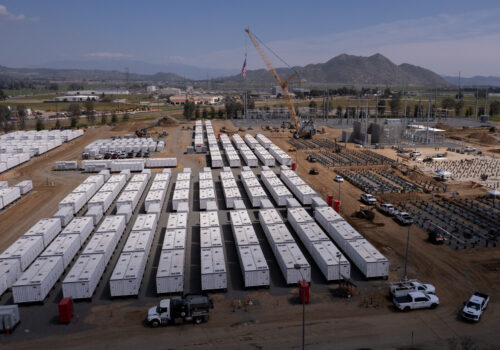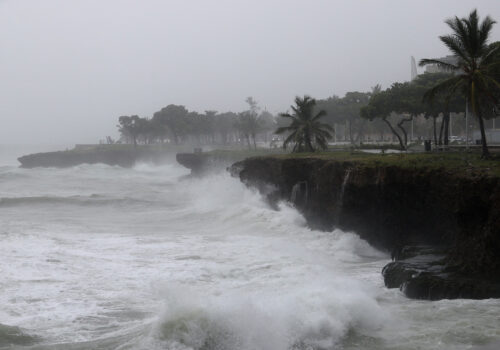Hurricanes could upend US oil and gas exports and global energy markets. Here’s what to know.
Texas and Louisiana are the crux of US oil and gas production but face severe, growing risks from hurricanes. With world liquefied natural gas (LNG) and crude products markets facing persistent, systemic risks from severe hurricanes in the US Gulf Coast, policymakers and industry actors need to expand contingency planning for major disruptions and take additional preparations.
The Atlantic hurricane season runs from June through November. The storms can begin as far away as the waters off the coast of Africa, gain power as they cross the ocean, and curl their way up through the Gulf of Mexico to make landfall in the United States. For example, eastern Texas and southern Louisiana have suffered from severe hurricanes and other weather events in recent years. In 2005, Hurricane Katrina flooded New Orleans, leading to more than 1,300 fatalities and vast economic disruptions. In 2017, Hurricane Harvey devastated entire sections of Houston. In early July of this year, Houston was hit by Hurricane Beryl, a Category 1 storm when it made landfall. Even though Category 1 is the least intense on the five-point scale, Beryl left nearly one million customers of CenterPoint Energy, a local utility, without electricity more than a week after the hurricane made landfall. This year, the Atlantic hurricane season is expected to be more active than normal, due to record-high sea surface temperatures and the shift from El Niño to La Niña.
This latest hurricane season is part of a trend: Gulf Coast hurricanes are increasingly worrisome. There is a strong correlation between Atlantic sea surface temperatures and the power dissipation index, an aggregate measure of Atlantic hurricane activity, accounting for frequency, intensity, and duration. Both have sharply risen since the 1970s. So, as climate change driven by greenhouse gas emissions continues to warm ocean surfaces, hurricanes will likely become more intense, with greater wind speeds and rainfall.
While hurricanes pose significant humanitarian risks along the Gulf Coast, they also disrupt world energy markets. The Gulf Coast is one of the world’s most important export markets for oil, LNG, and liquefied petroleum gas (LPG), which is typically used for petrochemical feedstock. It is also a top export site for refined products—sometimes called clean products—such as gasoline, diesel, and jet fuel.
LPG
The US Gulf Coast is a critical LPG exporter, sending huge shipments of propane and butane abroad. LPG is used as feedstock for the petrochemical sector, heating fuel, and engine fuel. In 2023, the United States shipped 1.6 million barrels per day (MMBPD) of propane abroad, with Japan, mainland China, Mexico, and South Korea serving as the largest export destinations. Total US butane exports totaled about 0.46 MMBPD. US Gulf Coast LPG export infrastructure is primarily located in the Houston Ship Channel, home to the Gulf Coast’s two largest LPG export terminals, although nearby Freeport and Nederland also host facilities. The Mont Belvieu natural gas liquids complex is also sited fewer than thirty miles from the Houston Ship Channel.
In the event of a major disruption to US LPG exports, importers across Asia would scramble to find alternative supplies.
LNG
US LNG facilities are already at significant risk of hurricanes due to their concentration in eastern Texas and western Louisiana. And as regional export capacity grows and hurricane intensity increases, there could be even greater disruptions to global LNG markets.
Significant hurricanes have passed throughout this corridor in recent years, causing major export disruptions. Sabine Pass LNG shook off the effects from Category 4 Hurricane Laura in 2020 after about a week. Cameron LNG, less than eighty miles away but directly in the eye of the hurricane, shut down for over a month. There is an uncomfortable tradeoff between electrifying operations at LNG terminals and making them more resilient. On the one hand, electrifying export terminals reduces their operational carbon dioxide–equivalent emissions footprint. On the other hand, facilities that receive power from underground gas pipelines are less vulnerable to hurricane-related disruptions than terminals that receive electricity from above ground wires.
Future hurricanes could be much more disruptive. Sabine Pass LNG, Golden Pass LNG, and Port Arthur LNG are all located along Sabine Lake on the Texas-Louisiana border, no more than eight miles from one another.
These three terminals will account for 66 million tons per annum (MTPA) peak throughput capacity, once Golden Pass and Port Arthur finish construction. For context, total US LNG exports totaled 13.6 billion cubic feet per day in December 2023, or roughly 103 MTPA. If these three facilities’ exports are disrupted by hurricanes, a price shock to global natural gas markets will result.
The US Gulf Coast has rapidly come to dominate global LNG flows, accounting for 19 percent of total volumes (79 million tons) in 2023, according to data from commodity firm Kpler. Notably, Sabine Pass LNG is already the single largest LNG export facility in the United States, shipping 29.5 million tons last year. A hurricane passing through the area could significantly delay the construction of Golden Pass LNG and Port Arthur LNG, and any US Gulf Coast hurricane-related outages this summer will have major impacts on world markets. Europe and Asia, the two largest recipients of US LNG exports, would be disproportionately affected.
Crude oil
The US Gulf Coast has also become a critical source of oil exports, accounting for just under 10 percent of total global seaborne departures in 2023, according to Kpler. Over half of all US crude oil exports (2.2 MMBPD) flowed through the Corpus Christi, Texas, export hub in 2023, on a volume basis. Houston was a critical second loading point (1.1 MMBPD), followed by smaller volumes out of Beaumont/Port Arthur (0.28 MMBPD), and other ports, such as Louisiana’s LOOP (0.26 MMBPD), shipping smaller volumes. While exports are concentrated at Corpus Christi, pipelines can ensure that these volumes are directed to other hubs—albeit only to a degree.
Refinery capacity and oil products
The Houston and Beaumont/Port Arthur regions are the country’s largest refinery markets, with approximately 2.5 MMBPD and 1.8 MMBPD of throughput capacity, respectively.
Disruptions to either refinery market would impact domestic and international markets for crude products, such as gasoline, diesel, and jet fuel. For instance, after Hurricane Harvey hit Houston and Port Arthur in September 2017, US retail gasoline prices rose by 13 percent in a matter of weeks. Surging prices were especially striking given that gasoline prices tend to decline in the fall, after peak driving season passes.
The US Gulf Coast is also a critical source of refined products, especially for Latin America. In 2023, Gulf Coast refiners exported 0.64 MMBPD of gasoline, 0.92 MMBPD of gasoil/diesel, and 0.14 MMBPD of jet fuel/kerosene, with roughly 80 percent of this volume flowing toward Latin America. However, US diesel exports have become an increasingly important source of supply into Europe, picking up to 0.17 MMBPD last year, up from just 0.07 MMBPD in 2022.
The time to deepen preparation is now
US natural gas and oil exports are growing, and much of the supporting infrastructure is located along the Gulf Coast. Unfortunately, these facilities are potentially vulnerable to hurricanes, and outages could have significant and persistent effects on US and world energy markets. Policymakers and industry actors, both in the United States and abroad, should carefully consider potential impacts from increasingly dangerous hurricanes and conduct further contingency planning. Concentrating energy infrastructure maximizes benefits from agglomeration and economies of scale while minimizing the tyranny of distance. Yet concentration poses significant risks that could prove disastrous in the future. With hurricanes only growing worse, the US Gulf Coast oil and gas complex must recognize and adapt to changing realities.
Joseph Webster is a senior fellow at the Atlantic Council’s Global Energy Center.
Reid I’Anson is a macroeconomist at the commodities firm Kpler.
Anya Herzberg is an intern at the Global Energy Center.
This article reflects their own personal opinions.
Further reading
Mon, May 13, 2024
California’s battery boom is a case study for the energy transition
New Atlanticist By Joseph Webster
The state’s large-scale deployment of lithium-ion storage batteries is leading to lower solar “curtailment,” or when electricity generation is suppressed due to price signals or physical oversupply.
Wed, Jul 3, 2024
Hurricane Beryl spotlights the importance of climate adaptation in the Caribbean
New Atlanticist By Wazim Mowla
The earliest category five Atlantic hurricane on record is a reminder that governments and the private sector must prioritize adapting to climate change. COP29 is a good place to start.
Thu, Jul 25, 2024
The world is sleepwalking into an era of extreme heat. The UN just issued a wake-up call.
New Atlanticist By Eleni Myrivili
The UN secretary-general‘s Global Call to Action on Extreme Heat underscores the urgent need for actionable heat-related policies worldwide.
Image: Flood waters caused by Tropical Storm Harvey encompass the Motiva Enterprises LLC in Port Arthur, Texas, U.S. August 31, 2017. REUTERS/Adrees Latif


